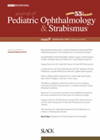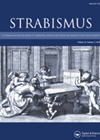
Journal Reviews archive for 2021
BT for cyclic esotropia
This paper describes two patients with childhood cyclic esotropia treated with botulinum toxin (BT) and followed for eight and nine years. Onset was at two and four years of age. BT was injected under electromyography (EMG) guidance bilaterally to medial...
Idiopathic orbital pseudotumor as first sign of systemic inflammatory disease
The authors describe four children in whom idiopathic orbital pseudotumor (IOP) was the initial solitary finding with systemic inflammatory disease developing later. Four children were seen over a five-year period. Mean age was 9.75 years (2-14). Three were white and...
Ultra-widefield fundus autofluorescence
The authors assessed the ease and utility of ultra-widefield fundus autofluorescence (UWF-FAF) in detecting suspected inherited retinal disease in children who were difficult to examine. They aimed to assess the sensitivity of UWF-FAF and UWF-CF (colour fundus) photography and clinical...
Impact of amblyopia on adult planning and problem solving
This study sought to evaluate whether monocular amblyopia has an impact on planning and problem solving in the adult population. The authors used the Tower of London (TOL) test to address this question. The TOL test was developed to assess...
PI drops and respiratory change during surgery
Five percent povidone-iodine (PI) topical application to the eye has been observed to cause apnoea under general anaesthetic (GAS). The authors designed a randomised single-blinded controlled trial to evaluate changes in respiration caused by PI eye drops. They recruited 100...
Brain abnormality as risk factor for consecutive exotropia
The authors evaluated and compared the cerebral MRI findings in operated infantile esotropia cases with and without consecutive exotropia. This was a retrospective study of 28 patients. Group 1 had 17 cases of consecutive exotropia with a mean follow-up of...
Surgical outcome for cyclic strabismus
The aim of this study was to report the outcome of surgical treatment in a series of seven cases of paediatric cyclic strabismus. This was a retrospective study of children with surgical treatment for the manifest cyclic deviation. Six children...
Detecting muscle insertion position by ultrasound
The purpose of this study was to investigate the accuracy to locate muscle insertion positions before and after strabismus surgery using wide-field ultrasound biomicroscopy with the bag / balloon technique. Thirty-nine muscles of 22 adult patients aged 34.7 ±15.5 years...
En coup de sabre scar and strabismus
This is a case report of an eight-year-old child with gradual progressive strabismus (esotropia and hypotropia) from the age of five years. The angle measured >45 degrees esotropia and 10 degrees hypotropia. There was a depressed linear-localised scar over the...
Surgical management of high myopia strabismus
This is a small case series of three patients with unilateral or bilateral high myopia with exotropia and hypotropia. Surgery involved nasal loop myopexy between the medial and superior recti muscles with or without lateral rectus recession and / or...
Improved suppression after surgery for intermittent exotropia
This study aimed to investigate the clinical factors associated with the recovery from suppression, with successful postoperative target motor alignment in 237 patients with intermittent exotropia. Mean age at surgery was 8.2 ±3.2 years and 48.5% were male. Preoperative angle...
Paralytic strabismus in Parry-Romberg syndrome
Parry-Romberg syndrome is a progressive hemifacial atrophy with idiopathic craniofacial disorder characterised by slowly progressive atrophy of soft tissues on one side of the face. A case is presented of acquired monocular elevation deficit in a child without restrictive component....






